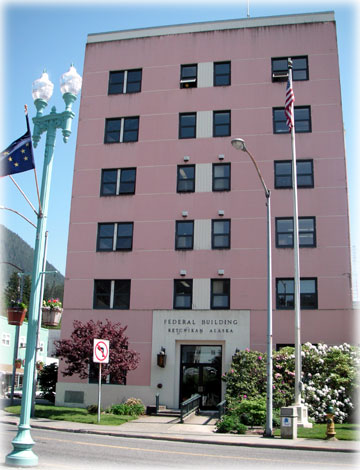 Ketchikan Federal Building Added to National Register of Historic Places By DAVE KIFFER June 14, 2006
The workers within its walls often call it the "Pepto (Bismo) Palace." Steve Williams, the former Ketchikan City Councilman who was on the committee that selected the current color, prefers to call it "Majestic Salmon Colored."
Now, the federal government has decided to call Ketchikan's first "skyscraper" - the Federal Building at Thomas Basin - historic. Earlier this spring, the federal building was placed on the National Register of Historic Places. It joins more than 20 other Ketchikan area sites on the National Register. The six story building, the tallest in Ketchikan until 1954, was built in 1937-38, replacing the Federal Courthouse that had stood on a hill near what is Grant Street since 1905. The first Federal Courthouse was on a plot of land adjacent to Ketchikan's first Main School. The space between the two site is now Grant Street and the Courthouse was where the Grant Street Playground now sits. It was a white boxy building, in sharp contrast to the Victorian gingerbread of the school house with its gables and cupola. Within eight years of the court house opening in 1905, there were already some concerns about its usefulness. In October of 1913, the Ketchikan Chronicle reported that a federal grand jury had requested the government build a new facility. "We find the condition of the federal jail is good, that it is clean and sanitary," wrote jury foreman Thomas Torry, who then suggested several minor changes to the structure, particularly the court house itself. "But even with these added facilities and improvements the accommodations for federal officials will yet be inadequate. As soon as possible the government should erect at Ketchikan a commodious fire proof building containing offices, court rooms etc." It would be a quarter of a century before the federal government would finally act on that request. 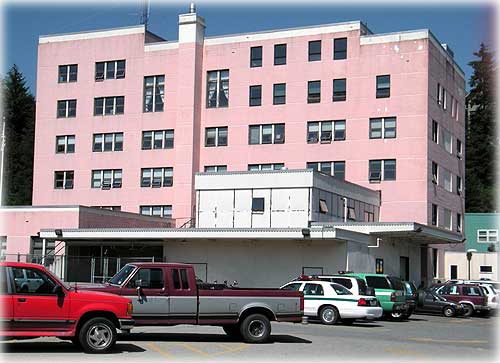 Photograph by Dick Kauffman - June 2006
The local school system had outgrown the first Main School on Grant Street above Downtown and plans were made to replace it with a three-story concrete structure and also build an additional school at White Cliff in Ketchikan's West End. With a newer, larger school being built on the hill, the Ketchikan Women's Council began advocating that the old court house be torn down and the site be turned into a playground. The Women's Council circulated a letter signed by Mrs. C.N. Elliot, Mrs. C.M. Taylor and Mrs. S. Oaksmith - listing its reasons. "1st The vital need for space where the children may indulge in the wholesome out door exercise so necessary to physical and moral development, and which is every children's right." "2nd The necessity for removing the jail from its proximity to the school house, as the suggestion and association is most undesirable in its moral effect upon the youthful mind." "3rd In connection with the transfer of the courthouse property the erection of a new Federal Building would become imperative. The need of such a building, large enough to house not only the offices of the Department of Justice, but all Federal offices in Ketchikan, is most apparent." 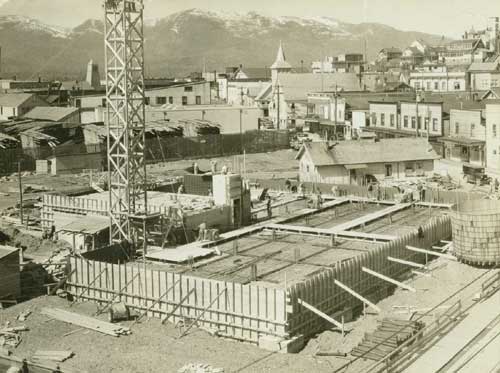 Photographer: Otto C. Schallerer Donor: Fred Greuter, Tongass Historical Society Photograph Courtesy Ketchikan Museums
The federal grand jury which continued to meet every six months to handle cases also continued to press for a new Federal Building. In 1923, it issued a special report that found the present building "dilapidated beyond reasonable repair and overcrowded past endurance." The report - printed in full in the Ketchikan Chronicle - also noted that the grand jury was concerned about the money the federal government was spending to rent space in other Downtown buildings. "However all that has been done or may be done (to renovate the building) here constitute but temporary or wasteful makeshifts," The report stated, it went on to list the various federal agencies that were spending a total of $9,000 a year to rent space. "The close proximity of the public school building to the Court House is also a source of great annoyance, it being frequently necessary to suspend the business of the District Court during school recesses because of the noise made by the children," Grand Jury Foreman Forest Hunt wrote. In 1924, the Ketchikan City Council sent an official plea to the Federal Government for a new facility. The request noted that the new school house under construction would further cramp the hillside locale. The city resolution suggested that it could provide a better site for a new federal building and that it would happily exchange land near the downtown for the court house site, which it would then turn into a playground. The next year, 1925, the federal grand jury once again petitioned the federal government for new building. 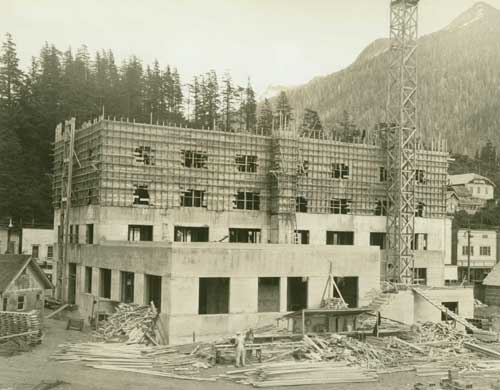 May 1, 1937 - Photographer: G.A. Geib Donor: John Granger, Tongass Historical Society Photograph Courtesy Ketchikan Museums "The Grand Jury examined the Federal building and found it in a very unsatisfactory, unsanitary and unsafe condition," wrote Jury Foreman J.D. Littlepage. "There is no question it is beyond repairThis building is, moreover, a firetrap and most unsafe place to confine prisoners." That year, the Ketchikan Commercial Club the forerunner of the Ketchikan Chamber of Commerce also added its voice with a resolution seeking a new federal building. But, while federal officials sent various letters of support, no action was taken on the request and the court house and federal offices continued to share the small hilltop with the new Main School and the numerous private dwellings. Finally, a decade later, relief came to Ketchikan in the form of the WPA. The Work Projects Administration was one of the largest of the government programs that was developed during the Great Depression to combat wide-scale unemployment by creating jobs. Billions of dollars were spent by the federal government on construction projects across the country that put millions of workers back to work, at least temporarily. "The Cleveland Ohio architectural firm of Stanley-Brown, Harris and Robinson designed a terra cotta-embellished semi-hexagonal building in 1933," Alison Hoagland reported in her 1993 book "Buildings of Alaska." "When construction bids exceeded the allotted amount, the firm redesigned, ending up with this five 12 story reinforced concrete building." In September of 1935, the Ketchikan Chronicle reported that new plans for a federal building had been revealed. The Chronicle reported that the treasury department planned to build a concrete building that was three stories high with a basement and penthouse which would hold a weather station. The first and second floors would hold the post office and the federal courthouse. At the time, there were alternate plans to include a jail on the premises. The Chronicle also reported that an initial $300,000 appropriation for the building had been supplemented with an additional $100,000. More than two years passed before construction started. The construction company of JB Warrack won the $350,000 contract. 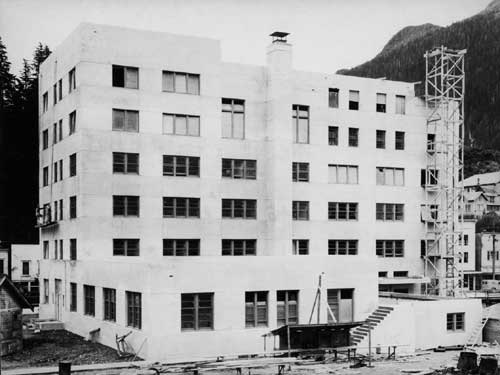 Photographer: Otto C. Schallerer Donor: Fred Greuter, Tongass Historical Society Photograph Courtesy Ketchikan Museums
The design had changed significantly from 1935. Now the building would have five full 50 by 117 foot stories and the half story "penthouse" as well as a 49 by 51 foot first floor "annex." that would house much of the Post Office work space. The new building was designed to hold 11 different governmental branches, according to the Ketchikan Chronicle.
Construction began in 1937 with more than 225 tons of steel and 17,000 sacks of cement. Like most other Ketchikan waterfront buildings, it was built using pilings but unlike the other buildings it was built on 276 steel rather than wood piles. Warrack told the Chronicle that made it unique in Alaska and the Pacific Northwest. "These piles are of H. type, driven to refusal in solid rock under the fill on which the new office structure is located," the Chronicle breathlessly reported. "As the solid rock is uneven, piles of different lengths were forced downward through the gravel until the driver could pound them no deeperthey were tested for refusal by placing a 50-ton tank of water on several of the steel supports." The building was also approximately five times larger than structures in the similar communities across the country, according to the website of the General Services Administration which has managed the building since 1976. The building was "overbuilt" to handle the numerous federal agencies. On Saturday, March 5, 1935, the Chamber of Commerce sponsored a special open house that featured speeches by local and territorial officials and a performance by a local band and choir. The Boy Scouts of America led tours of the new building. The Chronicle reported that more than 60 employees would work in the new building including representatives of the Forest Service, the Lighthouse Service, the Post Office, the Public Health Service, the Alaska Game Commission. the Federal Court system and the Alaska Communications System (ACS). The building required a full-time maintenance staff of eight. Another early tenant was the US Coast Guard which had just been branched off from the Lighthouse Service. The Alaska District Office was in Ketchikan - not Juneau - from 1940 to 1949. In the late 1950s, the jail portion of the building was expanded when the small jail in city hall closed. Prisoners would be housed at the Federal Building - and often seen exercising on the rooftop - until the new state jail was built in Bear Valley in the early 1980s. To pass the time, inmates worked on several murals on the jail walls. Those murals were preserved and are in the break room of the Social Security Office in the building, according to GSA staff. The expansion of Ketchikan in the 1950s and 1960s led to the decision to build a new post office on Ketchikan's waterfront in the West End near the Alaska Marine Highway Ferry terminal. For a while, a Downtown sub postal station was maintained in the Federal Building, but then the space was turned over to the Forest Service for a visitor information center. The creation of the State of Alaska in 1959 also changed the usage of the Federal Building as many governmental functions - such as the district and superior courts and fish and game - transferred from the federal government to the new state government. and were relocated when Ketchikan's State Office Building was erected at the corner of Main and Grant streets in the 1970s. After the GSA took over the building, the building was remodeled to create additional office space, primarily for the Forest Service, which was expanding its workforce in the Ketchikan area. In addition to the Forest Service, the primary current tenants are the US District/Bankruptcy courts and the GSA.
Contact Dave at dave@sitnews.us
|
||||
